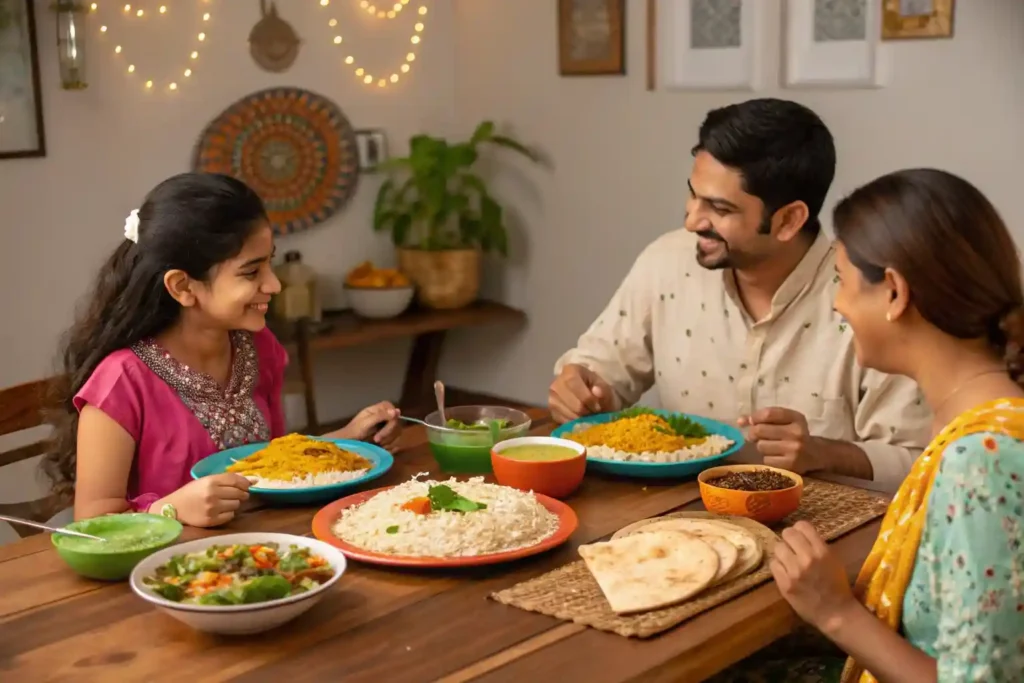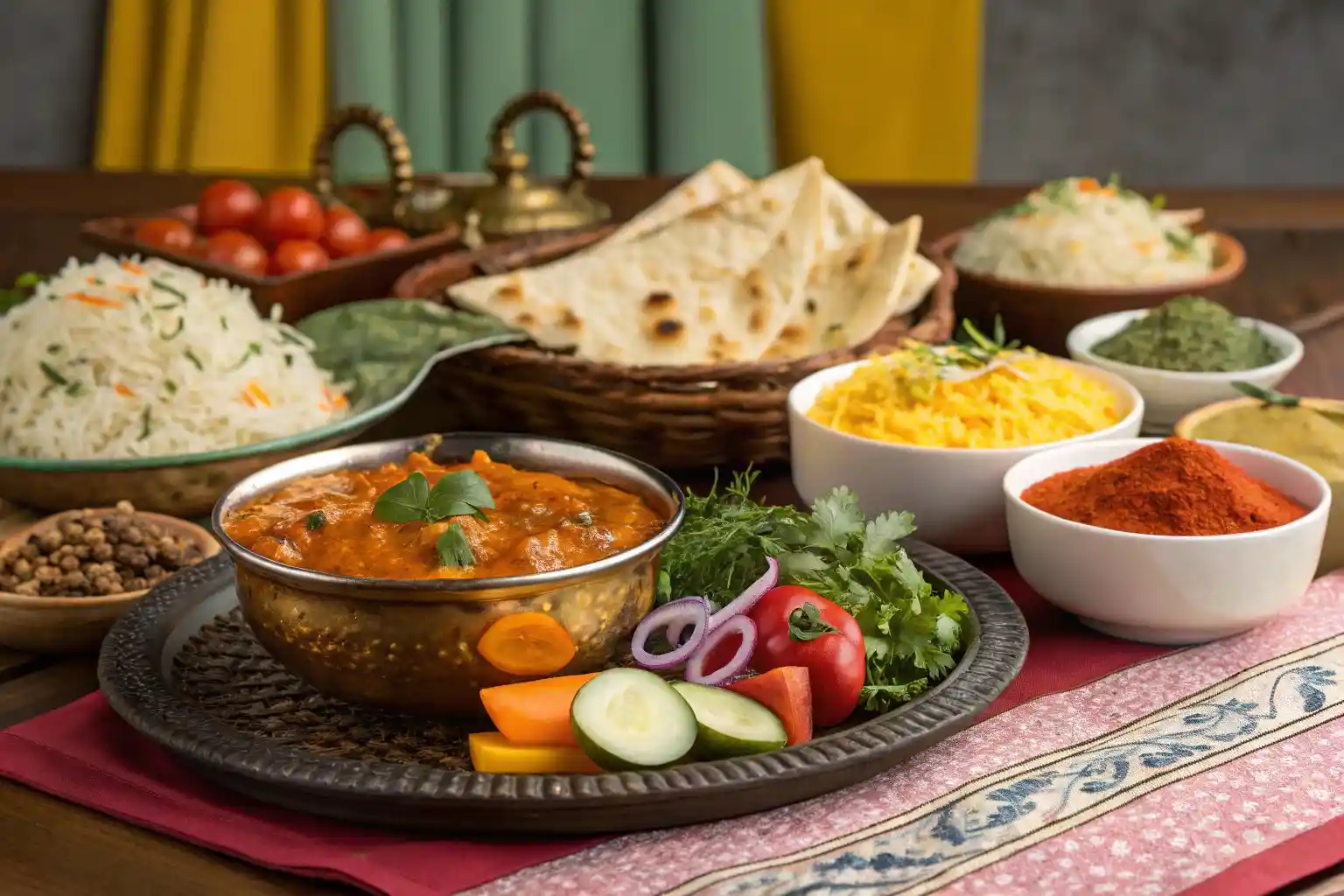Is Indian food healthy? This question often arises among those curious about the nutritional value of this vibrant cuisine. Indian food delights people worldwide with its bold flavors, aromatic spices, and diverse dishes. From creamy curries to colorful vegetarian meals, Indian cuisine offers something for everyone. However, many people wonder: Is Indian food healthy?
Table of Contents
The answer lies in the ingredients and cooking methods that traditional Indian recipes use. Cooks often prepare Indian food with fresh vegetables, whole grains, legumes, and a variety of spices. These ingredients not only enhance flavor but also provide numerous health benefits. For instance, staples like turmeric, ginger, garlic, and cumin boast anti-inflammatory and antioxidant properties. Additionally, lentils and chickpeas serve as excellent sources of plant-based protein.
However, like any cuisine, the healthiness of Indian food depends on how cooks prepare it. While some dishes are rich in nutrients and low in calories, others can contain high levels of fat, sugar, or sodium. In this article, we’ll explore the nutritional value of Indian food, its health benefits, and tips for making healthier choices when enjoying this beloved cuisine.
Key Ingredients in Indian Food and Their Health Benefits
Indian cuisine relies on a foundation of wholesome, nutrient-dense ingredients. Here’s a closer look at some of the most common ingredients and their health benefits:
- Turmeric: Known for its active compound curcumin, turmeric acts as a powerful anti-inflammatory and antioxidant. Cooks often use it in curries, dals, and rice dishes.
- Ginger: This ingredient aids digestion, reduces nausea, and has anti-inflammatory properties. You can find it frequently in Indian teas and savory dishes.
- Garlic: This ingredient lowers blood pressure and cholesterol levels while boosting immunity.
- Legumes (Lentils, Chickpeas, Kidney Beans): These foods provide rich sources of protein, fiber, and essential nutrients like iron and folate, making them a cornerstone of Indian vegetarian meals.
- Whole Grains (Rice, Millet, Roti): These grains provide sustained energy and serve as good sources of fiber and B vitamins.
- Vegetables (Spinach, Eggplant, Cauliflower): Indian dishes often feature a variety of vegetables, which pack vitamins, minerals, and antioxidants.
- Spices (Cumin, Coriander, Cardamom): Beyond flavor, spices like cumin aid digestion, while cardamom helps detoxify the body.
By incorporating these fresh, easy-to-find ingredients, Indian food can be both delicious and highly nutritious.
Health Benefits of Indian Food
1. Rich in Nutrients
Is Indian food healthy? Yes, it is naturally nutrient-dense, thanks to its reliance on whole foods like vegetables, legumes, and grains. For example:
- Vegetarian dishes like palak paneer (spinach and cottage cheese) or chana masala (chickpea curry) pack vitamins, minerals, and protein.
- Whole grains like brown rice or millet provide complex carbohydrates and fiber, which support digestive health.
2. Supports Digestive Health
Many Indian spices, such as cumin, fennel, and ginger, promote digestive benefits. For instance:
- Cumin stimulates the production of digestive enzymes, aiding in nutrient absorption.
- Ginger helps reduce bloating and nausea, making it a common remedy for upset stomachs.
Additionally, fermented foods like dosa (fermented rice and lentil pancakes) and yogurt-based dishes like raita promote gut health by introducing beneficial probiotics.
3. Anti-Inflammatory Properties
Spices like turmeric, ginger, and garlic receive recognition for their anti-inflammatory effects. Turmeric, in particular, contains curcumin, which researchers have shown can reduce inflammation and may help prevent chronic diseases like arthritis, heart disease, and even cancer.
4. Heart-Healthy Options
Indian food can support heart health when cooks prepare it with minimal oil and balanced ingredients. Lentils, chickpeas, and kidney beans provide excellent sources of soluble fiber, which helps lower cholesterol levels. Additionally, dishes cooked with healthy fats like mustard oil or ghee (in moderation) can support cardiovascular health.
5. Plant-Based Protein
For vegetarians and vegans, Indian cuisine offers a wealth of plant-based protein options. Dishes like dal (lentil soup), rajma (kidney bean curry), and tofu tikka not only satisfy but also provide essential amino acids.
6. Weight Management
Many Indian dishes remain naturally low in calories and high in fiber, making them ideal for weight management. For example:
- Tandoori dishes (grilled meats or vegetables) deliver flavor while remaining low in fat.
- Vegetable curries made with minimal oil can fill you up without adding excessive calories.
7. Boosts Immunity
Indian food features rich immune-boosting ingredients like garlic, ginger, and turmeric. These spices help fight infections, reduce inflammation, and support overall health.
Tips for Making Indian Food Healthier

While Indian food can be incredibly healthy, certain cooking methods or ingredients can add unnecessary calories, fat, or sodium. Here are some pro tips to make your Indian meals healthier:
- Use Less Oil: Many traditional recipes call for generous amounts of oil or ghee. Instead, opt for healthier oils like olive oil or reduce the quantity altogether.
- Choose Whole Grains: Replace white rice with brown rice, quinoa, or millet for added fiber and nutrients.
- Limit Cream and Butter: Creamy dishes like butter chicken or paneer makhani can contain high levels of saturated fat. Use yogurt or coconut milk as a lighter alternative.
- Increase Vegetable Content: Add more vegetables to your curries, stir-fries, and rice dishes to boost their nutritional value.
- Control Portion Sizes: Indian food often gets served family-style, which can lead to overeating. Serve yourself smaller portions and savor each bite.
- Avoid Deep-Fried Foods: While samosas and pakoras taste delicious, they contain high levels of calories. Instead, opt for baked or air-fried versions.
- Reduce Salt: Many Indian dishes rely on salt for flavor. Use herbs and spices to enhance taste without adding extra sodium.
By following these recipe hacks, you can enjoy the flavors of Indian cuisine while maintaining a balanced diet.
Nutritional Information and Benefits
Indian food offers a wide range of nutritional benefits, depending on the dish. Here’s a general breakdown of the nutrients found in common Indian meals:
- Calories: Many Indian dishes remain moderate in calories, especially vegetarian options like dal or vegetable curry. However, rich dishes like biryani or butter chicken can contain higher levels of calories due to added fats.
- Protein: Lentils, chickpeas, and paneer provide excellent sources of protein, making Indian food ideal for vegetarians and vegans.
- Fiber: Whole grains, legumes, and vegetables provide ample fiber, which supports digestion and helps regulate blood sugar levels.
- Healthy Fats: Ghee and mustard oil, when used in moderation, provide healthy fats that support brain and heart health.
- Vitamins and Minerals: Indian food remains rich in essential nutrients like iron, calcium, magnesium, and vitamins A, C, and E.
Health Benefits
- Weight Loss: High-fiber, low-calorie dishes like vegetable curries and lentil soups can aid in weight management.
- Heart Health: Spices like turmeric and garlic, along with fiber-rich legumes, support cardiovascular health.
- Immune Support: Ingredients like ginger, garlic, and turmeric boost immunity and fight inflammation.
By choosing nutrient-dense dishes and avoiding heavy, fried foods, Indian cuisine can serve as a cornerstone of a healthy diet.
Serving Suggestions and Pairings
Indian food tastes best when paired with complementary side dishes and beverages. Here are some serving ideas to elevate your meal:
- Side Dishes: Pair your main dish with whole-grain roti, brown rice, or quinoa for a balanced meal. Add a side of raita (yogurt with cucumber) to cool down spicy dishes.
- Salads: A fresh cucumber and tomato salad with a squeeze of lime complements rich curries perfectly.
- Chutneys: Mint or tamarind chutney adds a burst of flavor to any meal.
- Drinks: Traditional beverages like masala chai or mango lassi make great accompaniments. For a lighter option, try lemon water or green tea.
- Desserts: End your meal with a small portion of a healthy Indian dessert like kheer (rice pudding) made with almond milk or fruit salad with a sprinkle of cardamom.
These perfect pairings ensure a well-rounded and satisfying dining experience.
Conclusion
In conclusion, Indian food can be a healthy choice when prepared with nutritious ingredients and mindful cooking methods. While some dishes may be high in calories, many options are rich in essential nutrients. For instance, dishes like Healthy Enchiladas and Healthy Chicken Pot Pie showcase how Indian cuisine can be both delicious and nutritious. It’s essential to balance indulgent meals with healthier options. For more insights on the health aspects of Indian cuisine, check out this informative article on WebMD. By making informed choices, you can enjoy the vibrant flavors of Indian food while maintaining a healthy diet. Embrace the variety and richness of Indian cuisine, and you may find it to be a delightful addition to your healthy eating habits.

FAQ Section
1. Is Indian food good for weight loss?
Yes, many Indian dishes work well for weight loss, especially those high in fiber and protein, like lentil soups, vegetable curries, and grilled tandoori dishes. Avoid fried foods and heavy cream-based curries for the best results.
2. Can Indian food be gluten-free?
Absolutely! Many Indian dishes naturally remain gluten-free, such as rice-based meals, lentil curries, and dishes served with gluten-free breads like bajra roti (millet bread).
3. How can I make Indian food healthier?
Use less oil, replace cream with yogurt or coconut milk, and add more vegetables to your dishes. Opt for whole grains like brown rice or quinoa instead of white rice.
4. Is Indian food high in calories?
It depends on the dish. While some dishes like butter chicken or biryani can contain high levels of calories, others like dal or vegetable curry remain low in calories and nutrient-rich.
5. How should I store Indian food?
Store leftovers in airtight containers in the refrigerator for up to 3 days. Reheat thoroughly before serving. Curries often taste better the next day as the flavors meld together!

